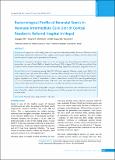Please use this identifier to cite or link to this item:
https://hdl.handle.net/20.500.14356/1716| Title: | Bacteriological Profile of Neonatal Sepsis inNeonatal Intermediate Care Unit of Central Paediatric Referral Hospital in Nepal |
| Authors: | Chapagain, R H Acharya, R Shrestha, N Giri, R B Bagale, B B Kayastha, M |
| Citation: | ChapagainR. H., AcharyaR., ShresthaN., GiriR. B., BagaleB. B., & KayasthaM. (2016). Bacteriological Profile of Neonatal Sepsis inNeonatal Intermediate Care Unit of Central Paediatric Referral Hospital in Nepal. Journal of Nepal Health Research Council. https://doi.org/10.33314/jnhrc.v0i0.673 |
| Issue Date: | 2015 |
| Publisher: | Nepal Health Research Council |
| Article Type: | Original Article |
| Keywords: | Neonatal sepsis Drug sensitivity Risk factor |
| Series/Report no.: | Sep-Dec, 2015;673 |
| Abstract: | Abstract Background: Sepsis is one of the leading causes of neonatal morbidity and mortality. Because of difference in localepidemiology and possible variation with time, regular monitoring and updates on pathogen and their antimicrobialsensitivity pattern is important for prevention and treatment. Methods: A retrospective descriptive study was carried out among cases of neonatal sepsis admitted in neonatalintermediate care unit of Kanti Children’s hospital from August 2014 to August 2015. The data was collected from medical records of neonatal intermediate care unit and microbiology department and analyzed using SPSS version 20. Results: There were 644 admissions, among which 210 (32%)were suspected of having neonatal sepsis. Thirty(14%)of the suspected cases had positive blood culture. Proportions of late and early onset were 25 (83.3%) and 5(17.7%)respectively.In blood culture Staphylococcus aureus was the most common organism(80%),followed by Coagulasenegative Staphylococcus (6.66%), Acinetobacter (6.66%), Enterobacter species(3.33%) and Morgonellamorgoni(3.33.5%).Gram positive organisms were isolated in all cases of early onset sepsis and in 84% of late onset sepsis. Mostof the isolated organisms showed sensitivity to amikacin, cloxacillin, ciprofloxacin and vancomycin. Conclusions: This study has indicated possible emergence of Staphylococcus aureus as the dominant cause of neonatalsepsis. Cloxacillin, amikacin, ciprofloxacin have high proportion of efficacy against the commonly isolated bacteria inneonatal sepsis. |
| Description: | Original Article |
| URI: | http://103.69.126.140:8080/handle/20.500.14356/1716 |
| ISSN: | Print ISSN: 1727-5482; Online ISSN: 1999-6217 |
| Appears in Collections: | Vol. 13 No 3 Issue 31 Sep-Dec 2015 |
Files in This Item:
| File | Description | Size | Format | |
|---|---|---|---|---|
| 673-Article Text-1263-1-10-20160317.pdf | Full text Article | 203.72 kB | Adobe PDF |  View/Open |
Items in DSpace are protected by copyright, with all rights reserved, unless otherwise indicated.
